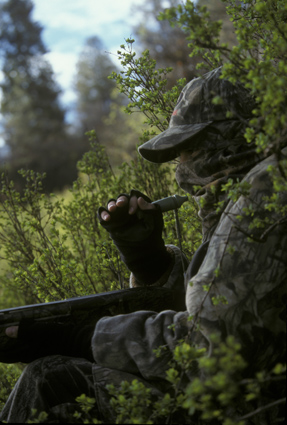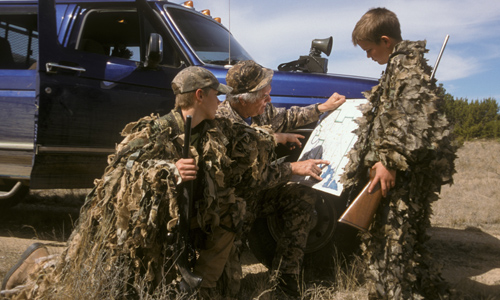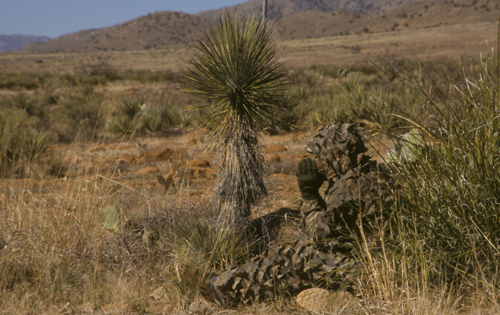 The sharp yelps from my wing-bone yelper barely faded when a gobble rolled off the oak-covered ridge 400 yards across the open meadow. I got comfortable under a low hanging juniper and eased my 12-gauge into shooting position. My concentration centered on the far side of the meadow, waiting for the gobbler to appear, when a sun bleached, ratty tailed, rubbed out coyote popped out of brush just off my left elbow.
The sharp yelps from my wing-bone yelper barely faded when a gobble rolled off the oak-covered ridge 400 yards across the open meadow. I got comfortable under a low hanging juniper and eased my 12-gauge into shooting position. My concentration centered on the far side of the meadow, waiting for the gobbler to appear, when a sun bleached, ratty tailed, rubbed out coyote popped out of brush just off my left elbow.
Normally I wouldn’t have given a moments’ thought to spooking the coyote away so I could concentrate on the gobbler. However, the previous evening when I stopped by the ranch house, the agitated rancher’s wife had shown me 11 newborn lambs killed by coyotes in their lambing pen early that morning. They actually killed 13 but carried off two.
When the coyote appeared, I slowly eased my shotgun up and flattened it with a hefty charge of No. 5's at less than 10 yards. My turkey hunt was over, but I felt pretty good about the morning’s hunt and even better when I showed the coyote to the rancher’s wife and daughter.
I had been hooked on prime furs and wouldn’t dream of killing a shabby furred, spring predator. However, that one earned me years of turkey, elk, deer, and predator hunting access to that ranch and was one of the most valuable shots I ever took.
Mother Nature adapted predators to be most deadly and efficient during the spring. Sure they take a toll on game during the winter, but in spring they make more serious inroads on the prey species than any other time. Wolves, coyotes and fox with a den full of pups to feed when females of all prey species are heavy with young or in the process of giving birth are at their killing best. After a long, tough winter the gaunt and winter weakened pregnant females of prey species and early newborn offspring are most vulnerable to four-legged predators.
I’ve seen many winter weary, weakened elk and mule deer that have been pulled down in the spring by coyotes with nothing but the fetus pulled out and consumed along with a few chunks of hindquarters. On several occasions the cow or doe was left alive by the satiated coyotes to die a prolonged death – so much for the humane side of nature.
 Sport hunting for predators when the fur is prime is one thing, but controlling predators to reduce populations calls for a completely different mindset. Effective predator control is best accomplished during the spring when predators are most susceptible to good calling techniques. You can often eliminate a whole generation of predator problems with a couple of well placed shots.
Sport hunting for predators when the fur is prime is one thing, but controlling predators to reduce populations calls for a completely different mindset. Effective predator control is best accomplished during the spring when predators are most susceptible to good calling techniques. You can often eliminate a whole generation of predator problems with a couple of well placed shots.
When government trappers were serious about reducing predator damage on wildlife and livestock, before the bunny huggers and politicos made effective methods politically incorrect, predicides (poison), aerial gunning and denning were used. Today, a predator call is without a doubt the most effective method of culling spring predators and reducing populations.
My first exposure to spring predator control and the effectiveness of howling came under the tutelage of Gary Rowley, a U.S. Fish & Wildlife predator control agent, my first spring as a conservation officer in Kremmling Colorado. A local rancher had lost over 30 lambs to coyotes and got in touch with Gary, who called and asked if I wanted to accompany him. No brainer.
We arrived at the ranch and took a quick look at the bloody lamb littered pasture. After studying tracks to ascertain the marauding coyotes travel patterns, we climbed a ridge overlooking the back side of the ranch where the tracks showed the coyotes took the lambs they’d carried off after their killing spree. Gary squatted under a tree and cut loose with a series of howls that would have done justice to any coyote. I was still wondering about his sanity when a few minutes later the predatory pair answered from far up a sagebrush choked canyon, pinpointing their location.
Early the next morning we sneaked to within a couple hundred yards of where we heard the coyotes. A few minutes after Gary assaulted the still morning with his agonizing critter squalls, two coyotes came out of the brush on the dead run and met a pair of sizzling .22 bullets from a .22-250 and .220 Swift. End of lamb killing problem.
 Several days later, I was out before daylight on a sage grouse mission, counting strutting birds. Shortly after daylight I heard several coyotes howling in the distance. I couldn’t resist trying my voice at howling. I made damn sure no one was around, then gave my best imitation of a coyote lone howl. I couldn’t believe it when a few minutes later a big coyote came loping out of the draw below me and ended up eyeing me from 40 yards away. Since that day, howling and especially springtime howling, has become an effective tool in my spring technique.
Several days later, I was out before daylight on a sage grouse mission, counting strutting birds. Shortly after daylight I heard several coyotes howling in the distance. I couldn’t resist trying my voice at howling. I made damn sure no one was around, then gave my best imitation of a coyote lone howl. I couldn’t believe it when a few minutes later a big coyote came loping out of the draw below me and ended up eyeing me from 40 yards away. Since that day, howling and especially springtime howling, has become an effective tool in my spring technique.
Howling will locate coyotes and their den sites for later assaults with conventional electronic and mouth blown calls. I’ve howled up many springtime coyotes for photography and for the challenge of seeing if I could. Howling is a super method of suckering aggressive and territorial spring coyotes into giving away their location or charging within gun range.
I made my first howler out of a discarded trumpet or coronet bell and an open reed duck call, which worked great for a number of years. Today I’ve got a bag full of superb howlers, with my favorites made by Dan Thomspon in Wyoming. My Foxpro FX-5 electronic caller has coyote locator howls, lone howls, group howls, aggressive barks, threat bark howls, and several other coyote vocalizations at the touch of a keypad. One of the most deadly, and my longtime favorite spring predator sound, is a canine pup or pups. Get within hearing of a den, use this sound, and get ready for fast action.
Spring predators are intensely interested in any sound that smacks of a free meal, and predator hunters never had it so good in the wide choice of sounds available from electronic calls. Squealing birds, rodent chirps, woodpecker distress, baby pigs, baby rabbits, chicken, pheasant and other bird distress sounds are all effective.
One spring while red fox hunting in Minnesota, I followed a bunch of fox tracks to a some old badger holes and found the fox had cached a bunch of dead piglets in the abandoned holes for later feeding. Don’t know whether the fox actually killed the piglets or simply scavenged them from a farm carcass pile. I hunkered down at the edge of a plum thicket a few hundred yards out and tried halfheartedly to imitate piglet squeals on my open reed mouth call. Within minutes, two red fox bounded across the pasture and right into shotgun range. Since then, I’ve tried squealing piglets several times on spring coyotes and have about a 25-percent success rate – higher in Texas where there are lots of wild pigs and lower in the northern states where there aren’t as many. There are no hard and fast rules as to what calls work best in the spring. If it sounds edible, there’s likely a predator interested somewhere.
One spring, shortly before the opening of turkey season I roosted several gobblers in the tall ponderosa around an old homestead and wanted to find their alternative roost, so I spooked them out of the trees just at dusk. They flew to the top of an adjacent timbered ridge so I hiked up in the near darkness, and yelped a couple times to pinpoint their location. I heard a thrashing of dry leaves and something slammed into my leg, scaring the hell out of me. Don’t know whether it was a bobcat or coyote, as all I saw was a blurred form in the near darkness. I was just glad it wasn’t a bear. Sure made me a bit more cautious about my background in late evening calling.
Thinning the number of predators on a ranch or farm in the spring, whether it’s a fox or coon killing chickens, a bobcat making inroads on turkeys, or a pair of coyotes killing lambs, calves or pets is a worthwhile venture and might open a few gates for you during deer season. It will definitely allow an extra deer or antelope to grow into a trophy or a clutch of turkey or pheasant chicks to make it to fall. If you can’t bring yourself to be a predator during the springtime and manage the four-footed predators in your hunting area, DON’T. Me, I’ll stick to predator hunting all year round and be glad I can.






